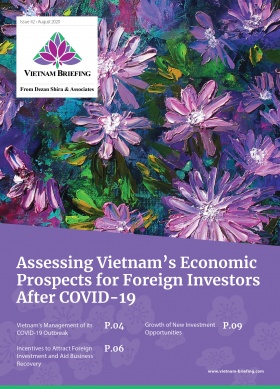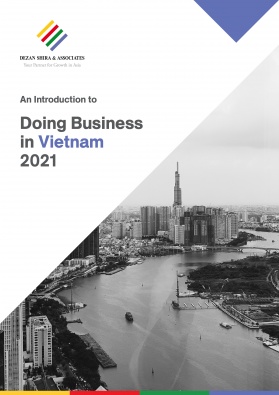Q&A: Understanding Vietnam’s Labor Market and Key HR Compliance
With a working-age population of over 54 million, a steadily increasing proportion of trained workers, and competitive costs compared to neighboring countries, Vietnam’s ample and affordable workforce has always been a key factor in driving foreign inbound investment.
In the current framework, as Vietnam develops into a prominent regional manufacturing hub, companies entering the market need to consider workforce availability and implement appropriate HR strategies to source an appropriate workforce as well as attract and retain the best talent.
To learn about Vietnam’s labor market, our International Business Advisory Senior Manager, Filippo Bortoletti, conducted a webinar on understanding Vietnam’s labor market along with key HR compliances. During the webinar, Filippo, discussed key characteristics and availability of the local workforce, taxes and insurance considerations, drafting a labor contract, and key conditions for terminating a labor contract. The webinar can be viewed here.
We highlight some insights below:
Can you give us an overview of Vietnam’s labor market?
With a population of over 96 million, Vietnam’s labor force makes up 57 percent of the population. The country’s main industries are manufacturing (16% of GDP), services (51%), and agriculture (14%) which employ a significant portion of the labor force. The unemployment rate at the end of 2019 was 2.1 percent.
The labor force is concentrated in different clusters across the country such as the Hanoi metro area, Hai Phong metro area, Da Nang metro area, and Ho Chi Minh City area. We also highlight Nghe An province in the north which has been receiving some attention in recent years and is a potential investment location for investors.
Can you describe these clusters?
Hanoi – Hai Phong metro area
The Hanoi – Hai Phong metro area has an abundant labor force with a young labor structure. The area has a total labor force of 12.7 million which accounts for 22 percent of the national labor force. The labor is most concentrated in industrial clusters such as Hanoi, Bac Ninh, Bac Giang, and Hai Phong. Nevertheless, investors should be aware of labor shortages that can occur in the manufacturing sector due to high turnover rates, especially in the peak season.
Factories typically employ a large number of migrant workers that are both skilled and unskilled. We assess that in the short term labor demand is expected to rise as additional industrial parks come up which may lead to higher competition for unskilled labor. Salary and other welfare will be key to retaining and attracting workers. In the long term, however, demand will gradually decline as factories employ automation techniques.
Due to high living standards and the good quality of labor, costs are high in the area. Labor costs are particularly high in Hanoi, followed by Bac Giang, Vinh Phuc, Hung Yen, and Hai Phong.
Tax incentives have been one of the key elements, making this area become an attractive investment destination for foreign direct investment.
Da Nang metro area
The Da Nang metro area’s workforce accounts for 56 percent of the population. It has a total workforce of 2.1 million which accounts for 3.8 percent of the national labor force. Its young and dynamic workforce has benefitted due to the world-class educational facilities in the area. Investors will find it comparatively easier to source qualified labor in the area due to well-established universities and vocational schools.
Da Nang’s investment climate is creating more jobs and competition for talent, particularly in tourism, real estate, education, entertainment and IT. While this has helped attract employees, some businesses have found it challenging to retain and hire high-tech workers and senior employees. While industrial parks in other parts of Vietnam are far from city centers, most IPs in Da Nang are within the city or right on the outskirts.
Labor costs are higher than the Hanoi-Haiphong metro area but less than the Ho Chi Minh City metro area. The local government’s pro-business policies attracts investors in fishing, infrastructure, services, and tourism industries. Incentives are also provided in specific areas such as the Da Nang High-Tech Park.
Ho Chi Minh City metro area
The Ho Chi Minh City metro area has one of the most abundant labor supply in Vietnam with a high share of migrant labor. The area is known as the commercial hub of the country. Labor is concentrated in industrial clusters such as Ho Chi Minh City, Binh Duong, and Dong Nai. The area has over 10.6 million in total labor force accounting for around 19 percent of the national labor force.
Labor pools in the area are diversified. Investment in services and a wide range of manufacturing provides access to a more niche talent compared to the central and northern regions. In the last decade, professional services, IT and hospitality labor pools have seen significant growth.
While talent is abundant, competition is high for talent among employers. In addition, labor costs in the Ho Chi Minh City metro area are some of the highest in the country. Within this area, labor costs are particularly high in Ho Chi Minh City, followed by Binh Duong, and Dong Nai.
Government incentives are available in terms of financial and non-financial privileges.
Nghe An province
Nghe An is one of the most densely populated provinces with the most abundant labor supply in Vietnam. The province has a total labor force of 1.9 million which accounts for 3.5 percent of the national labor force.
While most of the labor force is involved in agriculture, forestry, and fishery, the manufacturing sector has risen significantly in recent years. However, recruiting skilled labor can be a challenge especially for highly skilled engineers and senior managers. Most of the labor in such positions are from migrant labor. Labor costs in the province are some of the lowest among others due to a low standard of living compared to the North and the South. Most towns and districts come under the difficult to very difficult socio-economic conditions category.
Due to this, a wide range of tax incentives have been applied for projects in these areas such as CIT reduction, import and export tax exemption, land use tax reduction, and land lease fee exemption. The provincial government has also offered several incentives ranging from local labor recruiting and training to investment incentives with great socio-economic impact.
What does the future development of the labor market look like?
The pandemic has affected both the economic conditions and academic performance of candidates affecting high school students from taking exams. Candidates are also sensitive to increasing tuition fees at tertiary education institutions when deciding to study higher when graduating. The expensive education discourages students.
There is also a skills shortage with 50 percent of fresh graduates weak in terms of foreign language skills and adaptability to the work environment. Businesses can find it challenging to source technical workers locally. Specific conditions that require skilled labor are technical workers in various industries and designers in the garment industry.
Salary and other benefits remain key to attracting labor and in the future automation is likely to lead to jobs cuts. Therefore the labor force needs to improve skills to learn to adapt. Trade unions may also have greater influence in the future.
Top occupations that require vocational training are automotive, electronics, hospitality, mechanical engineer, and textiles and garments.
About Us
Vietnam Briefing is produced by Dezan Shira & Associates. The firm assists foreign investors throughout Asia from offices across the world, including in Hanoi, Ho Chi Minh City, and Da Nang. Readers may write to vietnam@dezshira.com for more support on doing business in Vietnam.
We also maintain offices or have alliance partners assisting foreign investors in Indonesia, India, Singapore, The Philippines, Malaysia, Thailand, Italy, Germany, and the United States, in addition to practices in Bangladesh and Russia.
- Previous Article Why Reforms are Necessary Despite Vietnam’s Successful Containment of Pandemic
- Next Article Vietnam Unveils New Criteria for Hi-tech Enterprises: Decision 10






























